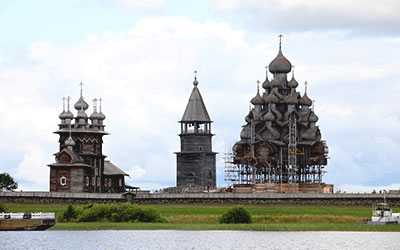
 تشكل المعالم الأثرية الخشبية جزءاً حيوياً من التراث التاريخي والثقافي العالمي، إلا أنها تتسم بالهشاشة وقابلية التعرض للتلف. ويجب حفظها باستخدام تقنيات وأدوات النجارة التقليدية. ومع ذلك، ينبغي على الخبراء في حفظ العمارة الخشبية مواكبة أحدث المعارف والاتجاهات في مجالي الحفظ والترميم، والاستفادة من التعلم على أيدي خبراء بارزين ضمن سياق دولي.
تشكل المعالم الأثرية الخشبية جزءاً حيوياً من التراث التاريخي والثقافي العالمي، إلا أنها تتسم بالهشاشة وقابلية التعرض للتلف. ويجب حفظها باستخدام تقنيات وأدوات النجارة التقليدية. ومع ذلك، ينبغي على الخبراء في حفظ العمارة الخشبية مواكبة أحدث المعارف والاتجاهات في مجالي الحفظ والترميم، والاستفادة من التعلم على أيدي خبراء بارزين ضمن سياق دولي.
تعد جمهورية كاريليا في شمال غرب روسيا غنية جداً بالمعالم الأثرية الخشبية، مما يجعلها بيئة مثالية لهذه الفرصة التعليمية.
حيث تعقد معظم فعاليات هذه الدورة في أكبر متحف مفتوح في الهواء الطلق في روسيا وهو متحف كيزي، والذي يضم مجموعة من 83 معلماً معمارياً خشبياً، من بينها موقع كيزي بوغوست المدرج ضمن قائمة التراث العالمي.
وقد طور القائمون على صيانة وترميم هذه المباني خبراتهم عبر تطوير تقنيات استثنائية في هذا المجال. وبناءً على توصية من إيكوموس واليونسكو، يسعدهم مشاركة هذه المعارف والتقنيات مع جمهور أوسع.
إن الهدف العام من هذه الدورة هو تحسين مستوى المعرفة المهنية وإعداد المشاركين للتطبيق العملي في مجال حفظ المعالم المعمارية الخشبية في بلدانهم. أما الأهداف المحددة، فتتمثل فيما يلي:
التعريف بخصائص العمارة الخشبية الروسية وتقاليد النجارة المرتبطة بها
تدريب المشاركين على تقنيات مراقبة وصيانة العمارة الخشبية
تزويد المشاركين بالمعرفة وتمكينهم في المهارات العملية المتعلقة بأساليب الترميم التقليدية والحديثة للعمارة الخشبية

